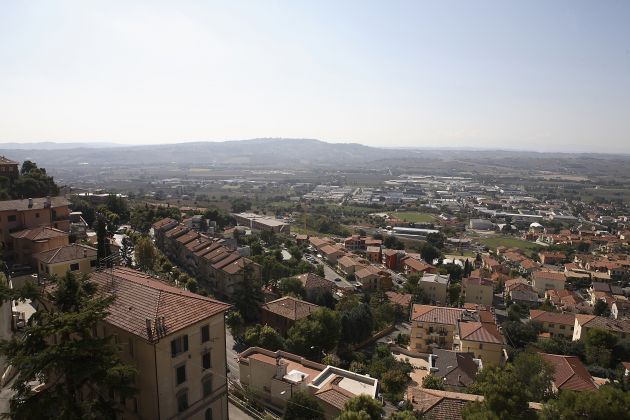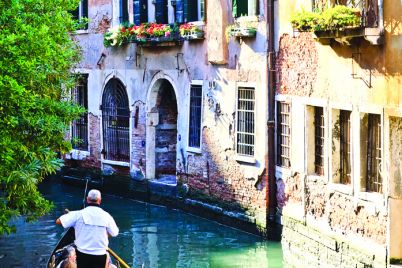Of the 40 million foreign tourists who flock to the “museum peninsula” every year, only a small fraction stop in the Marches. But a vast effort is underway to redress the situation.
Arguably the least heralded of Italy’s twenty regions, the Marches (le Marche in Italian) are nevertheless endowed with all the prerequisites of a first-class destination: modern infrastructure, untrammelled beaches, a treasure trove of picturesque villages, hearty cuisine, fine wine, and friendly people. Yet, of the 40 million foreign tourists who flock to the “museum peninsula” every year, only a small fraction stop in the Marches. On average, only 15 percent of two million annual visitors to the Marches come from outside Italy, according to recent statistics. But all this is about to change, if regional authorities have their way – a vast effort is underway to transform the Marches into a major tourist and business destination.
While the reasons for the Marches’ low profile are difficult to discern, its roots may well lie in the discrete nature of the Marchigiani people themselves. Like much of Italy, the Marches have a history of disunity, internal strife and foreign invasions. This may have contributed, in part, in conditioning the Marchigiani to be generally reserved and little inclined to sing their own praises. Instead, the focus has been on hard work, self-reliance and an unbridled desire for freedom.
This attitude clearly manifests itself in business. “Few Marchigiani would swap the independence that comes with running their own business, no matter how small, for a job working for someone else, no matter the benefits,” says Adriano Massone, director of the Italian Trade Commission office in Ancona. This is borne out by the facts: there are nearly 180,000 registered businesses in the Marche for a population of about one and a half million. The result is a vast array of small and micro-businesses in a wide range of sectors, including goldsmithing, lace-making, fashion design, majolica (decorative ceramics), pottery, papermaking, book binding, weaving, textile restoration, hospitality, dining, and wine-making. Musical instrument manufacturing, which began with the mass production of the accordion in the middle of the nineteenth century, continues to this day (see next article).
It is the realization that the Marches have inherent wealth in their natural environment and their artisanal manufacturing that has convinced the regional authorities to promote the region as both a tourist haven and a hub for high-quality artefacts and objets d’art – and in the process reinvigorate the region’s economy. As the Marches’ motto “all of Italy in one region” suggests, expectations are high.
In the same way that other jurisdictions and sectors have moved to protect their home-grown products – for instance DOC wines and cheeses, not to mention DOC Neapolitan pizza – so too has the Marches Region moved to create an official body to oversee the production of crafts and ensure their excellence by establishing and enforcing standards.
Says Carla Stramignoni, head of the Industry and Craft Trades Policies Unit for the Marches Region, “the Marche Eccellenza Artigiana (or Marches Excellence in Craftwork) authority has been set up to recognize and represent craftwork companies for the artistic merit and quality of their products, to recognize the distinguishing features of local production, and to distinguish traditional, handmade creativity from industrial manufacturing and imports from the Orient. The designation, symbolized by the 1-Marche insignia, is recognized by law. Artistic craftwork companies that meet the standards can be attributed the brand Marche Eccellenza Artigiana.”
A development program has also been established to promote geographical areas as well as sectors of activity by providing seed money for specific projects. The aim is to preserve, for example, artisanal workshops and traditional practices, as both functional businesses and as tourist attractions. Recent examples are the pillow lace museum and the farming implements museum in Offida, the traditional weaving workshop in Macerata and the accordion museum in Castelfidardo, to name a few. The preservation of traditional organic farming techniques, also on the “protected” list, have not just historical and didactic value, but are in line with modern concepts of sustainable farming.
A very extensive list of sectors are covered by the 1-Marche insignia, including tailor-made clothing, leather furniture, glassworks, ceramics, stone-cutting, glass decorating and engraving, mosaics, woodcarving, hat-making, clock-restoring – even gunsmithing and rosary-making. Currently, of the Marches’ 180,000 companies mentioned above, 50,000 are craftwork companies, and 5000 of these have been granted the 1-Marche Eccellenza status.
Creating a government body to ensure high standards and protect local production is fine, but how do you capitalize on this if the rest of the world doesn’t know? In the city of San Benedetto del Tronto in the southern Marches, a group of about forty artisanal manufacturers and boutiques have joined forces to form the Art for Job Consortium. Their aim: to employ modern marketing techniques to promote local products in export markets. With emphasis on innovation, originality, craftsmanship, and an efficient and coordinated strategy, the Consortium has become the nominal representative of Marches artisanal production to the outside world.
Says Art for Job Consortium president Sandro Angelini, “The Art for Job Consortium coordinates a totally new marketing project for the Marches, which aims to promote high-quality artistic craftsmanship for its uniqueness and versatility in foreign countries.” Through the Consortium, Marches products have been marketed from New York to Brussels to Kuwait and places in between.
The seriousness with which the Consortium sees its role is demonstrated by the fact that it also operates a full-fledged teaching establishment on its very premises, dispensing government accredited courses in traditional craftwork techniques to future artisans.
It is this new image of craftwork and, by extension, of the entire region – combining old and new, traditional and modern – that the Marches authorities aim to project to the world. They have every reason to be optimistic, as statistics for the last couple of years are trending upwards, in spite of the economic downturn.
First published in Accenti Magazine, Issue 18.




